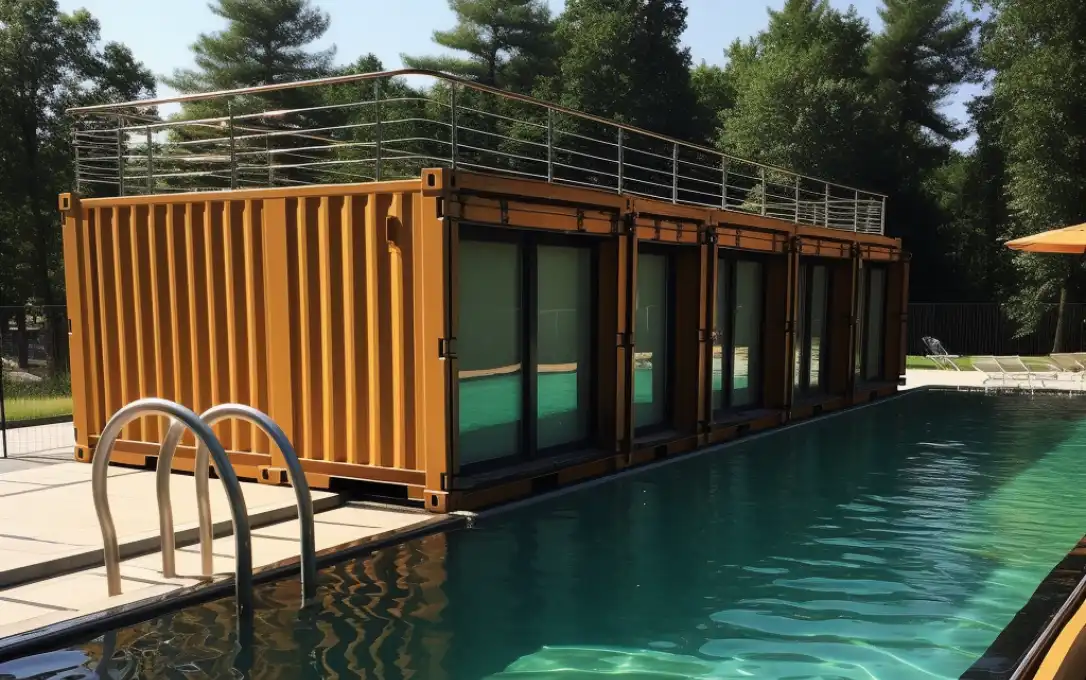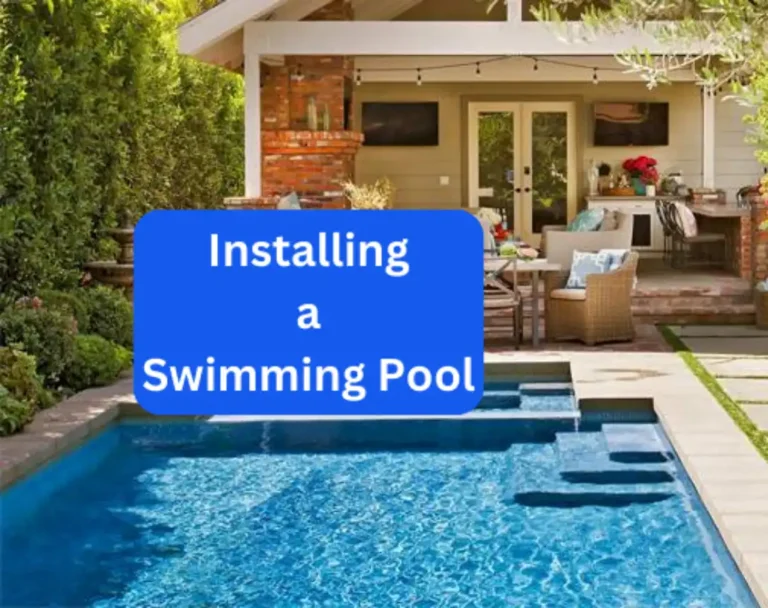Shipping container pools represent an innovative adaptation of classic swimming pool designs, leveraging the durability and distinct look of shipping containers. As an enthusiast of creative applications for these units, I’ve noted an increasing trend in transforming these containers into pools for both home and business use. The steel build and modular nature of the containers offer a robust and flexible solution for anyone in search of a customizable swimming pool option. With over a thousand container pools produced by manufacturers throughout North America, this idea has clearly demonstrated its effectiveness and appeal.

I appreciate the engineered approach that goes into converting shipping containers into pools. They’re often fitted with a durable interior lining and can come equipped with all the necessary pool equipment. Versatile in placement, these pools can be sited almost anywhere, from urban backyards to remote retreats, as long as the ground can be appropriately prepared and the local permissions are obtained. Their adaptability also allows for a range of sizes and depths, catering to various preferences and uses.
As I’ve researched the market, I’ve found that container pools can often be configured to include a variety of features, echoing the amenities of traditional pools, including options for heating, lighting, and even incorporated jacuzzis. Despite their seemingly industrial origin, manufacturers like Modpools and Trek Pools have demonstrated that container pools can be transformed into stylish fixtures that enhance outdoor living spaces, reflecting a blend of utility and modern design.
Understanding Container Swimming Pools

Container pools offer a versatile and often more affordable alternative to traditional inground or above-ground pools, combining modern design with flexibility in placement and style.
Concept and Popularity
The concept of a container pool involves repurposing strong and durable shipping containers into private swimming pools. This innovative approach has become increasingly popular as I’ve seen a rise in demand for unique backyard solutions. Not only are these pools a testament to the creative reuse of materials, but they also provide an option for those seeking a modern and often more cost-effective swimming space in their own backyard.
- Unique and Modern: Container pools are a distinct blend of modern aesthetics and practical design.
- Options: They can be installed as above-ground, inground, or partially inground pools, offering a range of options for homeowners.
- Popularity: I’ve noticed that their popularity stems from the combined desire for something unique and the growing interest in sustainable living.
Types of Container Swimming Pools
Container pools are typically available in two main types, each catering to different needs and space considerations.
- Standard Sizes: The most common container pool sizes are 8 x 20 feet and 8 x 40 feet, tailored to various backyard dimensions.
- 8 x 20 feet: Ideal for small spaces or lap swimming.
- 8 x 40 feet: Suitable for larger families or those who want more room for swimming activities.
- Depth Variability: Options for depth commonly range to accommodate different activities and safety requirements.


Lap Pools: These are long and narrow, catering specifically to those looking to swim laps in the comfort of their own backyard.
Above-Ground versus Inground: Some homeowners may choose above-ground container swimming pools for easier installation and portability, while others might opt for an inground or partially inground pool for aesthetic reasons and a more traditional pool experience.
- Design Customization: Container pools can be customized in depth and length, and I’ve seen designs with windows, varying colors, and decking added to enhance their appeal.
By considering the specific needs for a backyard space and personal preferences, container swimming pools present a compelling option for a customized swimming solution.
Design and Customization
In crafting a container swimming pool, I have the liberty to personalize both its design and functionality. My goal is to create a modern and aesthetically pleasing pool that also adheres to practical size and layout requirements.
Modern Design and Aesthetics
Container pools offer a sleek, modern look that can be customized to suit my tastes. Utilizing shipping containers, these pools blend industrial charm with contemporary design. I can choose from various modern design elements, such as the type of tile and add-ons that align with my aesthetic. The 3D pool studio or 3D online configurator offered by companies like Modpools provides an innovative way for me to envision and modify the design in real-time, ensuring a unique and personalized pool tailored to my preferences.
Size and Layout Considerations
The size and layout of a container swimming pool are crucial factors in the design process. The inherent modularity of shipping containers allows me to determine the pool’s dimensions based on my space and requirements. I have the flexibility to choose a single container for a more compact pool or multiple containers for an expansive swimming area. Moreover, the container swimming pool’s design can be further customized in terms of depth, length, and width, presenting an array of options that can cater to the diverse needs of any homeowner.
Construction and Installation
When I’m considering the integration of a container pool into a space, I focus on the balance of practicality and aesthetics. It’s essential to take into account the factors that influence both the construction process and the longevity of the pool.
DIY vs Professional Installation
I firmly believe that determining whether to install a shipping container pool through DIY efforts or via a professional service can greatly impact the project’s success. DIY installation can be a rewarding project, provided one has adequate skills and understanding of the process. It is critical to ensure all necessary permits are secured from local authorities to maintain legal and safety boundaries. In contrast, hiring a contractor can offer peace of mind and assurance of quality, typically starting with a quote for the service. A contractor’s experience with pool water systems, structural requirements, and backyard nuances can streamline the installation.
Materials and Durability
Shipping container swimming pools are known for their durability, thanks to their high-strength steel walls. The quality of materials used in construction is paramount, as this affects both the longevity and safety of the pool:
- Steel Quality: Container walls must be treated for rust prevention and structural integrity.
- Coatings: Protective layers help maintain durability against weather conditions.
I always recommend prioritizing pools manufactured from containers that are designed with both durability and adaptability in mind.

Essential Infrastructure
For any shipping container pool, essential infrastructure includes well-thought-out plumbing and filtration systems, as well as heating and insulation options for extended seasonal use. Here is what I consider:
- Foundation: It must be level and capable of bearing the container’s weight once filled.
- Plumbing and Filtration: Necessary to maintain clean and safe pool water.
- Heating: A heating system extends pool usability through colder months.
- Insulation: Insulation is crucial for heat retention and energy efficiency.
By carefully addressing each infrastructure component’s construction, the end result should deliver an inviting and sustainable backyard feature.
Costs and Budgeting
When considering the installation of a container swimming pool, I focus closely on the initial investment required and the budgetary considerations. Affordability and cost-effectiveness are paramount, alongside eco-friendly benefits. Moreover, financing options often facilitate the actualization of a backyard swimming pool for many homeowners.
Itemized Cost Breakdown
For a comprehensive understanding of pricing, obtaining a detailed quote that encompasses all facets is essential. Here’s a typical cost breakdown I’ve noted for a container swimming pool:
- Container Purchase: A 20-foot container typically ranges from $2,500 to $5,500, while a 40-foot container may cost between $4,500 to $7,000.
- Pool Liner: To ensure a leak-proof and smooth swimming surface, expect to pay between $1,000 and $3,500 for the liner, with variations depending on material and pool size.
- Installation: On average, installation costs can run from $16,500 to $47,000, inclusive of labor and any customizations.
- Pool Equipment: Pumps, filters, and other necessary pool equipment usually have a significant impact on the budget, though specific pricing fluctuates based on quality and technology.
Owners should remember that these ranges can shift based on location, contractor pricing, and market conditions.

Financing Options
Understanding my financing choices can make the difference between a feasible project and a wishful thought. Here are common financing options I’ve learned of:
- Pool Loans: Specialized loans tailored for swimming pool construction, offering various terms and rates.
- Home Equity Lines of Credit (HELOC): Utilizing my home’s equity to fund my pool, which might offer tax benefits.
- Personal Loans: An unsecured loan that doesn’t require home equity and is based on my creditworthiness.
Always comparing offers and terms carefully ensures that I choose the most cost-effective financing path for my container swimming pool project.
Maintenance and Upkeep
Maintaining a container swimming pool involves regular cleaning as well as measures to preserve its quality and extend its lifespan. As an owner, I need to be diligent with both routine maintenance and long-term upkeep strategies.
Routine Cleaning and Maintenance
I make it a point to skim the surface of my pool daily to remove debris. Every week, I vacuum the pool floor to prevent algae growth and maintain crystal clear water, ensuring all surfaces are free from dirt and grime. It’s crucial to keep the pool’s filtration system clean and in good working order; I do this by routinely checking and cleaning the filter according to the manufacturer’s instructions.
- Daily tasks:
- Skim debris off the water surface.
- Check and adjust the water temperature, if necessary.
- Weekly tasks:
- Vacuum the pool floor and walls.
- Inspect and clean the pool filter.
- Test and balance the water chemistry.
- Check pool equipment for signs of wear.
Longevity and Quality Preservation
I am aware that maintaining the equipment specific to container swimming pools is fundamental to their durability and lifespan. I conduct regular inspections of the pool structure for any signs of corrosion or damage, particularly since the container is metal and more prone to these issues. Ensuring that the water chemistry is balanced not only provides a safe swimming environment but also prevents the materials from deteriorating prematurely. To manage costs, I look for high-quality pool maintenance tools that are durable and provide long-term value, as investing in good equipment upfront often reduces long-term maintenance costs.
- Preservation tasks:
- Apply rust protection to the container.
- Check and repair sealants and coatings regularly.
- Monitor and maintain optimal pH and chlorine levels.
By following these maintenance steps, I can be confident in providing a safe, clean, and enjoyable swimming experience while ensuring that my container swimming pool remains in excellent condition for years to come.
Enhancements and Additions

When considering enhancing your container swimming pool, an array of options exists to elevate both utility and aesthetic. These upgrades range from functional add-ons to custom features that reflect personal style and practical needs.
Innovative Add-Ons for Functionality
I want to highlight the essential add-ons that boost the functionality of a container swimming pool. First, a filtration system is crucial; it ensures the water remains clean and clear for safe swimming. To cater to varying climates, installing a heating system expands the usability of the pool across different seasons. Here’s a brief list of functional enhancements:
- Filtration system: Keeps water in pristine condition.
- Heating: Allows for temperature control.
- Stairs or Ladders: Essential for safe entry and exit.
- Decking: Provides a non-slip surface around the pool.
- Lighting: Essential for evening use and to enhance safety.
Custom Features
My focus next shifts to custom features, which allow for personal expression and comfort. Decking around the pool can be tailored to match outdoor decor, offering both beauty and functionality. Consider the importance of a pool liner, which not only protects but also allows you to choose a color or pattern. Here’s what can turn a simple container swimming pool into a backyard centerpiece:
- Pool Liner: Aesthetic appeal and protection for the interior of the container.
- Lighting: Creates ambience and improves visibility at night.
- Finishing Touches: Including tile work and stylish accents.
By wisely selecting and integrating these enhancements and additions, your container swimming pool becomes not just a swimming area, but a customized, year-round retreat.
Regulatory and Compliance Issues
In this section, I’ll discuss the critical legislative and compliance matters that you must navigate to successfully implement a container swimming pool. These regulations ensure safety and legal conformity, which are essential to the successful operation and maintenance of your pool.
Understanding Local Regulations
When considering the installation of a container swimming pool, the first thing I do is inform myself about the local zoning laws and building codes. These dictate where the pool can be placed and detail any necessary permits needed before construction. I always check with my local government authorities to obtain the correct permits. If I live in a community governed by a homeowners association (HOA), I also review their rules, as they may have their own set of restrictions regarding container pools which may affect boundaries or aesthetic considerations.
Safety Standards and Compliance
Regarding safety, it’s my priority to align with the standards prescribed by relevant bodies. I follow the Model Aquatic Health Code (MAHC), which outlines safety standards for swimming pools and spas. The MAHC recommends barriers to restrict access and prevent accidental drownings. This includes fences with self-closing and self-latching gates. I ensure the pool structure itself is robust and that any electrical installations comply with the National Electrical Code (NEC) to avoid hazards.
Additionally, I comply with the Occupational Safety and Health Administration (OSHA) regulations, ensuring that required safety equipment is accessible for maintenance staff. This includes proper signage, such as exit signs and notices about the pool’s depth or no-diving policies. I make sure that the container swimming pool meets all these criteria for a secure and legally compliant swimming environment.
Advancements and Trends

In my review of the latest developments in container swimming pools, I have observed notable technological innovations alongside a significant push toward eco-friendly and sustainable practices.
Technological Innovations
I’ve seen a shift towards leveraging technology to enhance both the design and functionality of container swimming pools. This includes the adoption of 3D pool studio software, allowing customers to visualize their dream pool in a virtual environment before installation. I’ve also noted the integration of modular systems in construction, which streamlines the process, making it both time and cost-effective. Moreover, accessibility to pool configurations via an online 3D configurator is a modern convenience that harmoniously blends technology with customer service. This tool empowers users to tailor their choices from the comfort of their homes, effectively scaling the impact of personal design through digital means, which I find particularly notable.
Eco-Friendly and Sustainable Practices
When I turn my attention to the environmental elements of container swimming pools, I am struck by the dedication within the industry to eco-friendliness and sustainability. An EcoPool concept, which emphasizes a reduced ecological footprint, is gaining traction. It involves using recycled shipping containers as the pool shell, which is a testament to the innovative repurposing within the industry. Furthermore, these pools are often affiliated with energy-saving technologies and systems designed to minimize water use, which aligns with modern sustainable living standards. Social media platforms like Instagram play a pivotal role in raising awareness about these eco-friendly alternatives, allowing companies such as Trek Pools to showcase their sustainable and modern designs to a broader audience.
The integration of eco-friendly practices with industrial materials illustrates a responsible approach to modern living, where sustainability has become as important as utility and aesthetic.
Potential Challenges

In discussing potential challenges of container swimming pools, I’ll focus on two main areas: the environmental and site-specific factors that can influence the installation and use of the pool, and the financial implications that stem from cost and budgeting concerns.
Environmental and Site Challenges
When installing a container swimming pool, environmental conditions play a significant role. A key concern in colder climates is the potential for the pool to shift due to frost heave. This means that the pool could move from its original position as the ground freezes and thaws. Consequently, a solid and secure foundation is critical to mitigate such risks. In addition, local boundaries must be considered to ensure proper placement within the property without any infringement on public or private lines.
Cost and Budgeting Concerns
Cost is a pivotal factor for anyone considering a container swimming pool. While generally more affordable than traditional pools, there are still considerable expenses to factor in. For instance:
- Initial Investment: The cost of acquiring the container and transforming it into a functioning pool.
- Additional Expenses: This includes decking, water features, or premium add-ons.
- Maintenance Costs: Regular maintenance is necessary to keep the pool in good condition, which can add up in the annual budget.
The size and layout of the container can also influence the budget. A larger pool requires more materials and consequently a higher financial commitment. It’s imperative for potential owners to budget carefully, keeping in mind all the possible expenses, both upfront and ongoing.
User Experience and Reviews
In my research, I’ve discovered that user reviews and firsthand accounts are critical for assessing customer satisfaction with container swimming pools. These insights often highlight the quality and craftsmanship of the pools, the service provided by contractors, and real-world application in varied backyard settings across the USA, including states like Texas.
Customer Testimonials

Positive Feedback:
- Customer Satisfaction: I’ve read numerous reviews where customers express delight with the swift installation process and the innovative designs that complement their backyard space.
- Social Media Buzz: On Instagram, there are many users showcasing their container pools, praising their sturdiness and aesthetic appeal, which seems to generate trust and interest among followers.
Constructive Criticism:
- Concerns are sometimes raised over the long-term maintenance and potential for rust, suggesting that continuing service and support are crucial for a positive experience.
Case Studies and Real-World Examples
Example 1:
- Location: Texas, USA
- Quality and Craftsmanship: A case study showed that a family in Texas was satisfied with the quality of their container swimming pool, noting that the craftsmanship surpassed their expectations.
Example 2:
- Service: In another instance, the speedy and reliable service by contractors during installation was highlighted, with the family appreciating the contractor’s attention to detail and clear communication.
Frequently Asked Questions

In this section, I will cover some common inquiries people have about shipping container swimming pools, which are innovative alternatives to traditional swimming pools, like glass swimming pools or wood swimming pools, offering both versatility and ease of installation.
How are shipping container swimming pools constructed?
Shipping container swimming pools are made by converting used shipping containers into pools with the addition of a pool liner, filtration system, and sometimes a frame or decking. This process generally includes treating the container to prevent corrosion and ensuring its structure is suitable for holding water.
What is the average cost of a modpool?
The average cost of a modpool, which is a brand of luxury shipping container pools, typically ranges from $27,000 to $50,000, depending on the size and customization options chosen.
What materials are used for lining shipping container pools?
For lining shipping container pools, materials commonly used include heavy-duty vinyl and fiberglass inserts, which provide a watertight and smooth surface for the interior of the pool.
Can shipping container pools be installed underground?
While shipping container pools are usually installed above ground, they can also be installed partially or fully underground with proper structural support and waterproofing measures to prevent corrosion and withstand soil pressure.
What sizes do shipping container pools come in?
Shipping container pools commonly come in standard shipping container lengths, typically 20 feet or 40 feet, with custom dimensions also possible depending on the provider and customer’s requirements.
Are shipping container swimming pools a viable alternative to traditional pools?
Yes, shipping container swimming pools are a viable alternative to traditional pools as they are cost-effective, have shorter installation times, and can be customized to fit various spaces and aesthetic preferences, all while being more environmentally friendly by repurposing existing containers.
Your opinion matters! If our blog post on container swimming pools sparked any thoughts or reflections, share them with us in the comments below.






